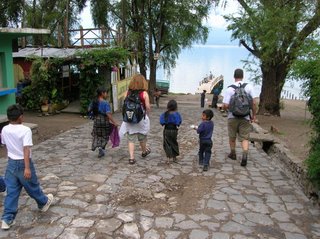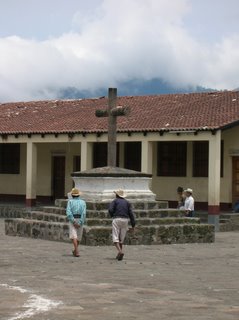
There was no access to the internet for the last few days in Guatemala, so I'll be catching up in the next few blogs.
After Santa Apolonia, we made our way to Panajachel... the incredibly tacky little tourist town on the shores of Lake Atitlan. The drive was a bit of an adventure. Julio was gracious enough to take us in his minivan. Only one stop by the local police and one flat tire, but we made it safely. After winding over mountain ridges for two hours, we descended down through the town of Solola and on to Pana. A few miles outside of the city, the road opened up onto breathtaking views of Lake Atitlan and its three breathtaking volcanoes.

We made our way to the main street lined with restaurants and shops, including many stalls stocked with local crafts and staffed by the locals in their traditional Mayan clothing. We stayed just off the main strip at the Bungalows El Aguacatal (the Avocado). They were not bad, once Jim cleared the spiders out of my bedroom. To be honest, it was awfully nice to allow someone else to do that for me! I am so used to taking care of myself.
We spent one day on a private boat tour of the lake. I realize the irony of going from a small town in mountains of Guatemala to a private boat tour on Lake Atitlan. I am not sure how to resolve it in my own mind. In high school, I probably would have wanted to cancel the remainder of my trip, giving all my money to those in need in Santa Apolonia. Now I know enough to see that my small gift would do little to change the great inequities in our world, the systems that continue to make the rich richer and the poor poorer. But is that any reason not to live sacrificially? Have I succombed to the greed of my culture? Have I chosen an easy path of discipleship rather than the road less traveled? I work hard for my money and shouldn't I be able to enjoy the material benefits God has given me? But can I really say that I work harder than any of the people of Santa Apolonia? Do I even work a fraction of the hours they do?

With all those thoughts swirling around in my mind, we boarded our small barco with David, a local college student and amateur photographer, who captained his father's boat. The water was smooth and glassy. The views were amazing. Over each of the volcanoes hung a billow of clouds that looked like they were pouring out of the crater.
David took us on a tour of three of the smaller towns nestled in the hillsides around the edge of the lake. There were few tourists in the villages. And most of the women and men wore traditional Mayan clothing.

In the first town, Santa Catarina, we watched a parade of school children carrying posters about ecological issues in Guatemala. Children greeted us at the boat and escorted us back to the lake selling small trinkets and offering to pose for pictures for a quetzal. Cathy spoke to each and everyone of them. She was amazing with the children.

In San Antonio Palopo, we hiked to the small Catholic church on the hillside with a fantastic view of the lake. Along the way we found a small outlet store for local pottery and a building where they demonstrated various weaving techniques.

The main street was bustling with the Monday morning market. This time Cathy befriended an older Mayan woman who insisted on showing her how to tie up her hair according to the local fashion. Cathy, of course, eventually bought the brightly woven fabric tie for her hair.

The final town, Santiago Atitlan, was the main tourist destination on the other side of the lake. Nestled at the back of an inlet at the base of the San Pedro volcano. As we floated into the town, we saw several men fishing along the shoreline and a group of women doing laundry. As we pulled up to the dock, several boys ran up to us offering to show us Maximon, the local party saint. Known for his smoking and drinking and hidden in a small, dark room in the back of a small home, we passed on this opportunity. Instead, we made our way to the church in the local square. In the church was a monument to the people of Santiago Atitlan who were killed during the civil war. Santiago Atitlan is known for being the first village in the country to expel the armed forces. For years it was caught between the guerillas based on the hillsides and government forces. Hundreds disappeared accused of siding with the guerilla army. In 1990, drunken soldiers shot a villager. The townspeople had finally had enough. They marched in mass to the army base. In fear, the soldiers opened fire killing 13 and wounding 20. The incident drew international attention and the army finally withdrew from the town.
1990... just 16 years ago this town was occupied by armed forces. Today, in the center square, villagers are gathered with bushels of avocadoes, loading them on brightly painted chicken buses to send to market. And Cathy, Jim, and I are wandering peacefully through the streets with little sense of the willpower and strength of these people.
1 comment:
So much history on those streets... I like how you write about the tension (favorite seminary word) between poor and rich, good and evil, people and things. thanks for sending me the link to this window into Guatemalen culture. what have you brought back with you internally? do you have more pictures of the people or were you afraid of exploiting them?
Post a Comment